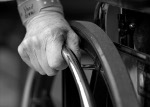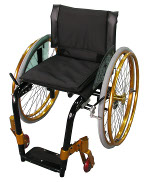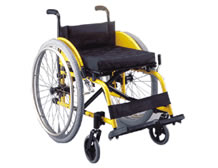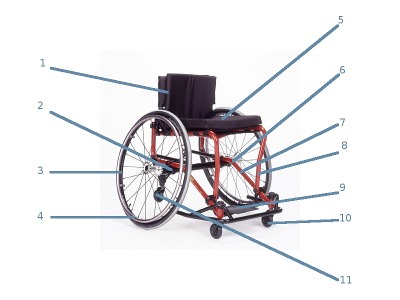The Wheelchair Guide
Your Wheelchair and Mobility Scooter Resource
What Are Manual Wheelchairs and Why Are They So Popular?
Tuesday, April 13th, 2010
 Choosing the best type of wheelchair is something that often comes down to personal preference, although there are certainly a number of other factors involved in this decision, such as physical capabilities and cost. For many, despite the allure of an electric wheelchair, even those heavy duty models that can be driven almost anywhere, a manual wheelchair is still the first choice.
Choosing the best type of wheelchair is something that often comes down to personal preference, although there are certainly a number of other factors involved in this decision, such as physical capabilities and cost. For many, despite the allure of an electric wheelchair, even those heavy duty models that can be driven almost anywhere, a manual wheelchair is still the first choice.
Manual wheelchairs have been used for thousands of years, but the modern design used today is based off of a 1930′s wheelchair called the E&J Wheelchair, developed by Everest and Jennings, two inventors. While there have been many improvements to the manual wheelchair since then, including improved metal working techniques and axle technology, the basic design is quite similar to these early models, which features a hollow metal frame to reduce weight, as well as allowing the wheelchair to be folded when not in use.
A lot of physical effort is required to use a manual wheelchair, which is propelled by the user who pushes on the large rear wheels. A set of hand-rims extends from the wheel, which allows the wheels to be spun easily, without having to touch the part of the wheel that makes contact with the ground. Of course, while many people choose to self propel their manual wheelchair, most also have push handles on the back, so the wheelchair can be pushed from behind.
The front rigging of the wheelchair is the part where the user rests their feet and typically provides two foot rests, although some provide only a single long foot rest, which can be folded up or removed quite easily. A set of parking brakes is also usually attached to the larger rear wheels, which work by simply applying pressure to the wheel and lock in place, holding the wheelchair still.
One of the main improvements to the original E&J Wheelchair has been to the rear axle. The axle connects the two rear wheels, allowing them to spin in unison and makes it possible to move the wheelchair easily in a straight direction, as well as making turning easier. Not only has the axle itself been improved mechanically, but many wheelchairs now offer a movable axle, which allows the user to change the weight distribution of the wheelchair, as well as reducing or increasing resistance.
Of course, cost often also plays a factor, as manual wheelchairs are much less expensive than electric wheelchairs.
A Quick Look At Sports Wheelchairs
 There are many types of manual wheelchairs and one type that has become quite popular in the last 10 or 20 years is the sports wheelchair. Sports wheelchairs come in a variety of designs and styles, including many specialized wheelchairs designed for specific wheelchair sports.
There are many types of manual wheelchairs and one type that has become quite popular in the last 10 or 20 years is the sports wheelchair. Sports wheelchairs come in a variety of designs and styles, including many specialized wheelchairs designed for specific wheelchair sports.
For example, sport wheelchairs designed for wheelchair racing have a very long wheelbase, with the front wheels extending several feet from the rest of the wheelchair, helping to improve stability. Wheelchairs designed for wheelchair basketball, on the other hand, typically have a special metal guard around the chair to protect the user.
Of course, sports wheelchairs do not always have such a glaringly different design and many are simply designed to be as light as possible, while including mechanical upgrades to improve performance. Often, they will feature a more comfortable seat that is made out of a very breathable material, as opposed to the vinyl often used in manual wheelchairs, as well as a lower back or even no back at all. Many find that sports wheelchairs are more practical, even though they don’t play a particular sport.
For instance, for those that work indoors, the lower backrest found on most sports wheelchairs makes it much easier to turn and work around a desk without being inhibited. So, it is common for people to prefer a sports wheelchair over a standard design.
How Manual Wheelchairs Work
Friday, October 2nd, 2009
Wheelchairs have been around, albeit in a much less standard form, for thousands of years. Their roots can be traced back to images of ancient oriental devices, which were designed to provide a way for those who could not walk to get around. Today, despite there being a great number of wheelchair manufacturers around, the general design of the manual wheelchair has become much more standardized.
The modern manual wheelchair is based off of the more than 70 year old E&J wheelchair design, which features a hollow metal tube frame, two large rear wheels, and a smaller set of front wheels. When not in use, the frame can be folded, making it easier to transport and move the wheelchair.
Standard Manual Wheelchair Design
 The large rear wheels allows the user of the wheelchair to self-propel, grasping the rear wheels, which have an extended rim, called a handrim, that does not come in contact with the ground and user to spin the rear wheels.
The large rear wheels allows the user of the wheelchair to self-propel, grasping the rear wheels, which have an extended rim, called a handrim, that does not come in contact with the ground and user to spin the rear wheels.
Even though many manual wheelchairs are designed to be self propelled, this is not always the case. Some manual wheelchairs, called transport wheelchairs or transfer wheelchairs, are designed only to be pushed from behind, so feature much smaller rear wheels. They also have a set of push handles that extend from the top of the wheelchair frame, on both corners of the top seat. Most manual wheelchairs also include these push handles, although sports wheelchairs frequently do not.
The front rigging of the manual wheelchair refers to the footrest and supports, which can often be removed and adjusted to increase comfort. The front rigging varies by wheelchair, but most provide a metal foot rest, which can be folded up to allow the wheelchair user to enter and exit the chair.
A braking system is also present on most standard manual wheelchairs, although sports wheelchairs, which have a slightly different design in general, often do not include brakes. When brakes are present, however, they usually use a simple design that holds the rear wheels in place using a simple vice, which is applied separately to both wheels. This allows the person using the wheelchair to easily set the brake, with only a little pressure.
Anti-tip casters are another important feature, which extend from the rear of the wheelchair frame. They are basically like little arms, which are designed to make contact with the ground if the wheelchair tips over too far backwards. The anti-tip casters can not always prevent a fall, but they often make tipping over backwards much less dangerous.
Sports Wheelchairs vs Manual Wheelchairs
 More and more, the sports wheelchair is becoming popular, not just for those who play wheelchair sports, such as wheelchair basketball or wheelchair racing, but also those who simply find sports wheelchairs more comfortable and practical. One major difference between sports wheelchairs and manual wheelchairs is the seat design.
More and more, the sports wheelchair is becoming popular, not just for those who play wheelchair sports, such as wheelchair basketball or wheelchair racing, but also those who simply find sports wheelchairs more comfortable and practical. One major difference between sports wheelchairs and manual wheelchairs is the seat design.
Manual wheelchairs usually use a vinyl like material, which is sewn around the hollow tubed frame. Sports wheelchairs, on the other hand, often use a much more breathable material, which is usually softer and a good deal thicker than the vinyl seat found on a conventional wheelchair. This makes it more comfortable and less likely to cause irritations due to sweat, as well as drying much quicker.
Another major difference is the backrest. Most manual wheelchairs have a full backrest, which sports wheelchairs usually have a much smaller and lower backrest. This is one of the features that many non-sports playing wheelchair users appreciate, because it can be much more comfortable and practical indoors, allowing for a much larger range of movement in regards to the arms and shoulders. This can be important when working at a desk, as it allows the wheelchair user to reach around easily.
There are many other differences between sports wheelchairs and manual wheelchairs, including how the front rigging is designed, as well as the size and angle of the wheels. The axle is usually much different on a sports wheelchair as well.
Sports Wheelchair Parts Diagram
Tuesday, June 23rd, 2009
There are a great number of wheelchairs on the market and it is very important to find one that will fit the needs of its user. The sport wheelchair, or ultralight wheelchair, is very popular, both by people who are very active and those who simply find it easier and more comfortable to use.
*Please Note that some of the items below are not present in the picture, because they are not usually found on a sports wheelchair.

- Backrest
- Rear Axle
- Rear Wheels
- Handrims
- Seat
- Frame
- Traverse Bar
- Front Rigging
- Footrests
- Front Casters
- Anti-Tip Casters
- Brakes
- Tipping Levers
- Seatbelts
- Push Handles
- Upholstry
- Armrests
- Metal Skirt
1. Backrest: The backrest of a sports wheelchair is usually lower than a conventional wheelchair. Typically the backrest will be between 11†and 15â€. The backrest is also usually adjustable and models are also available that span 7†to 11†and 15†to 19â€. A lower backrest can allow for increased upper body movement.
2. Rear Axle: While on a conventional wheelchair, the axle is located directly below the backrest, many sports wheelchairs have adjustable axles. They can be positioned closer to the front of the chair, reducing the wheelbase and making the wheelchair more maneuverable. While typically much more maneuverable and easier to push, a smaller wheelbase also reduces the stability of the wheelchair. To increase stability, at the expense of maneuverability, the axle can be moved backwards towards the rear of the wheelchair. It also makes it a little harder to push, but increase the power of the stroke. Instead of a moving axle, some sports wheelchairs have a moving seat instead.
3. Rear Wheels: The rear wheels are usually the same size as on conventional wheelchairs, but sometimes for racing larger wheels are used. They feature sealed precision bearings and are designed to be as lightweight as possible. This makes the wheelchair easier to move and reduces friction. They also usually feature a quick release button, so the axle can be moved or wheel replaced quickly and easily. Most use spoked wheels, although some sports wheelchairs have solid molded rims.
Typically pneumatic tires are used, often allowing for a much higher pressure than traditional pneumatic tires. Pneumatic tires are great for outdoors, because they provide better shock absorption outdoors. Like racing bikes, the tires are often very narrow.
Often, the camber of the wheel, its angle, is often adjusted, much like you would adjust a sports car, with the bottom of the wheel farther out than the top. This brings the wheels closer to the users body, allowing for more energy efficiency. A wider wheelbase also offers the advantage of a more stable wheelchair that is also easier to steer.
This can pose a problem when indoors when dealing with narrow doorways and makes transporting the wheelchair more difficult. Some now allow the camber to be quickly adjusted to a “toe in†mode for indoor use though.
4. Handrims: The handrims are typically coated in foam that is covered in vinyl, although the rim itself is made of metal. This makes it easier to grab, however the vinyl can be very slick and result in finger burns. More or less padding can also be added, to deliver a variety of grip sizes.
Often smaller handrims are used, which require more energy to get started, but allow for a higher top speed. The smaller handrims also allow for the individual to maintain their speed easier. In many regards the size of the handrim is much like the different gears on a bike.
Sometimes for those with very limited upper body strength or mobility, small extensions are added to the handrail, which extend away from the wheelchair at an angle, making the wheels easier to turn.
5. Seat: The seat often has pieces of velcro attached to it, allowing cushions and bags to be attached. The lower backrest of the seat allows for a greater range of movement and slightly elevates the knees, improving stability.
6. Frame: The frame of a sports wheelchair is made of metals that are very lightweight, such as aluminum, titanium, and graphite. Often, the entire wheelchair will weigh only 25 pounds, which is about half of what a conventional wheelchair weights. There are some, however, that can weigh as little as 15 pounds. The lighter the frame, the easier it is to propel.
Traditionally the frame of sports wheelchairs had been rigid. This improved its performance and made it much sturdier, but it also made it harder to transport. The seat would have to be folded forward and the larger rear wheels would be removed. However, as of late, several manufacturers have begun making folding sports wheelchairs, which makes transportation much easier.
7. Traverse bar: The traverse bar replaces the crossbars found on conventional wheelchairs and helps make the frame sturdier. On folding sports wheelchairs, the frames are equipped with locks to prevent it from folding unless needed.
8. Front Rigging: The front rigging refers to the footrest and the bars that connect it to the frame. Traditionally, the front rigging was not detachable, which improved the stability of the frame. However, this could make transferring into and out of the chair more difficult, some some sports wheelchairs now feature detachable and swing away front rigging.
9. Footrests: The footrest is typically one piece and made of several metal tubes, instead of a platform. It is usually closer to the frame than conventional wheelchairs, reducing the sports wheelchairs turning radius.
10. Front Casters: The front casters are typically made out of solid polyurethane, although some use pneumatic or solid rubber tires. The casters are smaller than those on a conventional wheelchair, usually only 4†to 5†in diameter. However, on racing wheelchairs larger front casters are often used.
11. Anti-Tip Casters: Anti-Tip casters prevent the wheelchair from tipping backwards completely and are often not included on newer wheelchairs.
12. Brakes: Most sports wheelchairs do not have brakes, although some choose to use them. If used, scissor brakes are most popular and mounted lower down on the frame, so the users hand does not become entangled when pushing or the brake accidentally activated. (Not Pictured)
13. Tipping Levers: Typically the tipping lever, which makes it easier for someone pushing the wheelchair to tip the wheelchair backwards and navigate curbs, are much smaller than those on conventional wheelchairs. (Not Pictured)
14. Seatbelts: Seatbelts are usually available for most sports wheelchairs as an option. Some wheelchair users that are very active will use a safety harness to provide more support. (Not Pictured)
15. Push Handles: Many sports wheelchairs do not have push handles, because of the added weight. Instead, fabric straps are added to the back of the seat, to provide a handhold. Some, however, do have push handles. (Not Pictured)
16. Upholstry: Most sports wheelchairs have reinforced nylon or darcon upholstry. This is very lightweight and strong, but unlike vinyl, it is not as easy to clear. (Not Pictured)
17. Armrests: Most sports wheelchairs do not have armrest, which reduces the weight, while allowing the user a better pushing angle. It also increases the users range of upper body movement. (Not Pictured)
If armrests are present, they are usually lightweight and removable. Typically they are not strong enough for the user to use them to transfer into and out of the wheelchair.
18. Metal Skirt: A metal skirt is also usually not present, for both wheelchairs with and without armrests, so the user will risk dirtying their clothes or catching them in the wheels. (Not Pictured)
Other Types of Sports Wheelchairs
There are many different popular wheelchair sports and almost all of these types of sports use a slightly different wheelchair design. For example, the footrest and front rigging of a wheelchair that will be used for wheelchair basketball has a built in foot guard to add more protection. Wheelchairs for wheelchair rugby have an even more protective front guard, as well as more protection around the wheels.
Wheelchairs that are used for racing are elongated to provide stability, so the front wheels often extend several feet from the wheelchairs seat. Since there is so much diversity among the design of sports wheelchair, it is important to decide what you want to use the wheelchair for and to speak with a professional or other wheelchair user to determine what type of wheelchair will be best. It is also not uncommon for many wheelchair users to prefer the design of a sports wheelchair, even if they do not intend to directly use it to play sports.